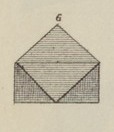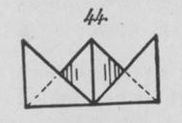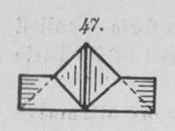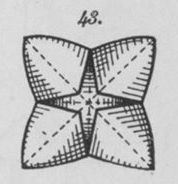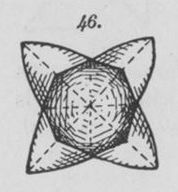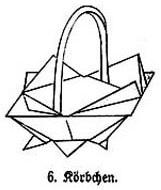| The Public Paperfolding History Project
x |
|||||||
| Designs from the Double Blintz Basic Form | |||||||
| This
page attempts to record what is known about the history
of designs developed from the Double Blintz Basic Form.
Please contact me if you know any of this information is
incorrect or if you have any other information that
should be added. Thank you. These designs are almost all Froebelian in origin. They fall into two categories, Folds of Beauty and Folds of Life. ********** Froebelian Forms of Beauty Details of the history of Forms of Beauty developed from the two sides of the Double Blintz Basic Form can be found here. ********** Froebelian Forms of Life The Salt Cellar and the Pepperpot - 1836 onwards
********** The Travel Bag - 1859 onwards
********** The Flat Flower - 1863 onwards The Flat Flower (De bloem) is illustrated in 'De Kleine Papierwerkers 1: Wat men van een stukje papier al maken kan: Het vouwen' (The Small Paperwork 1: What one can make from a piece of paper: Folding) by Elise Van Calcar, which was published by K H Schadd in Amsterdam in 1863.
********** 1869 A design called 'Ein Blume', which is not illustrated, but which from the context is most probably the Flat Flower, appears in a list of designs in 'Der Kindergarten' by Hermann Goldammer, which was published by Habel in Berlin in 1869. ********** 'Paradise of Childhood' by Edward Wiebe, which was published by Milton, Bradley and Company in Springfield, Massachusetts in 1869, and is effectively a translation of Goldammer's 'Der Kindergarten', similarly includes a 'flower' in its list of Forms of Life. ********** The Collar - 1863 onwards
********** De sokjes (the sock) - 1863 De sokjes (the sock) is illustrated in 'De Kleine Papierwerkers 1: Wat men van een stukje papier al maken kan: Het vouwen' (The Small Paperwork 1: What one can make from a piece of paper: Folding) by Elise Van Calcar, which was published by K H Schadd in Amsterdam in 1863. It is made by folding the het chemisetje (the Collar) in half backwards.
********** Het schuurbakje (the Sandbox) - 1863 Het schuurbakje (the Sandbox) is illustrated in 'De Kleine Papierwerkers 1: Wat men van een stukje papier al maken kan: Het vouwen' (The Small Paperwork 1: What one can make from a piece of paper: Folding) by Elise Van Calcar, which was published by K H Schadd in Amsterdam in 1863. It can be made by by opening out two corners of the flower then folding the inwards to the centre, then folding the resulting shape in half.
********** The King's Crown - 1882
********** The Queen's Crown - 1882 This variation of the Crown first appears in part two of 'The Kindergarten Guide' by Maria Kraus Boelte and John Kraus, which was probably first published in 1882 by E. Steiger and Company in New York.
********** The Seedpod - 1882 This design, which is developed from the Salt-Cellar, appears in part two of 'The Kindergarten Guide' by Maria Kraus Boelte and John Kraus, which was probably first published in 1882 by E. Steiger and Company in New York, as 'The Half Closed Flower'.
********** The same design appears in Lois Bates' 'Kindergarten Guide', which was first published by Longmans, Green and Co in London in 1897.
The Open Seedpod - 1882 This design, which is developed from the Pepperpot in the same way as the seedpod is developed from the Salt-Cellar, appears in part two of'The Kindergarten Guide' by Maria Kraus Boelte and John Kraus, which was probably first published in 1882 by E. Steiger and Company in New York, as 'The Open Flower'.
********** The Bed - 1887 onwards
********** The Table and Cover - 1897 This design first appears in Lois Bates' 'Kindergarten Guide', which was first published by Longmans, Green and Co in London in 1897.
********** The Basket with Handle - 1887 onwards
********** |
|||||||

